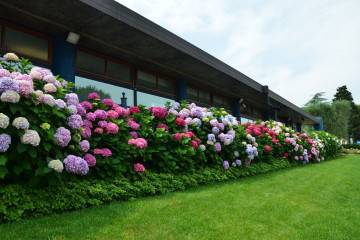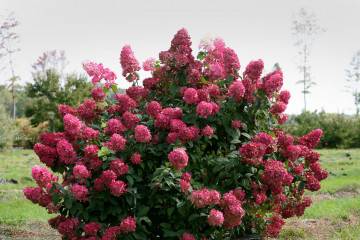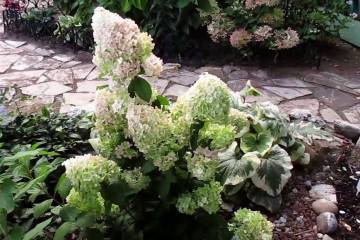Hydrangea Polar Bear - description and care of the plant
Content:
Hydrangea is a godsend for the gardener. A thriving shrub is used to decorate a summer cottage, create a hedge, and single plantings. The Polar Bear is a type of panicle hydrangea that has won the hearts of gardeners with its special elegance, unpretentiousness and frost resistance.
General information about hydrangea Polar Bear
The flower with the proud name Hydrangea (Hydrangea), which means "a vessel with water", was spoken about at the beginning of the 19th century. The history of its name conceals many myths. For a long time, the plant was attributed exclusively to indoor flowers. Today it is a garden bush, which, thanks to the work of experienced breeders, boasts a huge variety of varieties.
The Polar Bear variety (paniculata grandiflora polar bear) was born by crossing the lush but weak Grandiflora with the robust variety of the Limelight bush. The second subspecies is distinguished by small but beautiful flowers that change color depending on the month of flowering.
The new variety has incorporated the best qualities of both parents. It is distinguished by large compact cone-shaped inflorescences. Cap-shaped flowers reach 40 centimeters in size. Due to the abundant, voluminous flowering, the Polar bear hydrangea resembles a shaggy, voluminous ball.
The basis of the round frame is strong branches. Inflorescences change color depending on the month of flowering. The light green shade shimmers with pink in the spring in the fall. During the main summer flowering, the bushes are snow-white. Hydrangea Polar Bear begins to bloom from the middle of summer and pleases with a riot of colors until severe cold weather. The plant tolerates low temperatures well. Green leaves are prone to yellowing.
How panicle hydrangea reproduces
Bushes are propagated in universal ways:
- cuttings;
- rooting of young shoots;
- dividing the bush;
- seeds;
- by vaccination.
The method of rooting green shoots is carried out during the formation of the bush. Unnecessary overgrown shoots are placed in water for several days. After that, they are cut into several parts so that 4 internodes remain on each. After that, the panicle hydrangea can be planted in open ground.
The most popular among gardeners is the method of rooting hydrangea with paniculate cuttings. The material is planted in soil consisting of equal proportions of peat and sand. Root the stalk correctly two-thirds of its length. Cover with plastic wrap on top.
Planted cuttings need a constantly moist soil, so it is advisable to store the planting material in a cool room (for example, a basement is good), in pots.
Planting in soil
Open planting of bushes is carried out in early spring or autumn before frost.When planting a fragile plant in the spring months, it is better to focus on a sunny area, without drafts. It is important that the Polar bear hydrangea receives maximum sunlight in the morning. To avoid drafts, it is advisable to plant hydrangea near the fence or wall of the building. During sap flow, the plant is vulnerable to cold.
Autumn planting in the ground involves warming hydrangeas. The bushes grow stronger and become immune to frost only after 3 years. The plant is planted to a depth of half a meter. The hole width is about the same. They spill a hole in advance. It is advisable to pour three buckets of water into the hole the day before planting.
In the morning of the next day, two types of fertilizer are laid: peat mixed with earth and sand with humus. Of the two types of fertilizers, one is formed. Mix both compositions in a two to one ratio. Urea, potassium sulfate and superphosphate are added to the resulting fertilizer. The finished assortment is poured into the pit, leaving fifteen centimeters on top.
A young hydrangea plant is planted, spreading the roots, and sprinkled with ordinary earth. Bushes love black soil and clay soil. It is advisable to add peat, pine needles, iron vitriol to slightly acidify the earth. Sandy soil requires more maintenance and frequent feeding.
Hydrangea Care Polar Beer
Hydrangea bushes are quite unpretentious to care for. But they still require some attention to themselves and the implementation of certain activities. The process of protecting the roots by mulching with peat or sawdust from unpleasant weather is especially important.
How and how much to water
Hydrangea paniculata Polar bir is a moisture-loving plant that requires constant watering. It is important to prevent the roots from drying out. Better to water the bushes with warm water, you can rain.
Potassium permanganate is an excellent addition to watering in minimal doses. With proper moisture in a dry season, about thirty liters of water per plant can be consumed in 7 days.
Shrub pruning
Beautiful bushes are an important element of garden decor. The correct design contributes to the lush flowering of the plant, and the well-groomed appearance pleases the owners.
The timely formation of the bush will save you from chopping flowers and diseases. Pruning is done in spring or February. This is done in the densest places, in order to evenly distribute the access of sunlight.
It is correct to shorten strong branches by two-thirds of their length. It is important to keep from 3 to 5 kidneys. Weak shoots are cut off completely.
Top dressing
Access to nutrients ensures maximum flowering. The plant should be fed in the spring after the buds are formed.
Organic mixtures with the addition of urea, potassium, superphosphate are ideal for this. From mid-July, when watering, complex additives are added to the water, and closer to winter - mineral fertilizers intended for hydrangeas.
Loosening and weeding also play an important role in the development of the bush.
How hydrangeas survive the winter
The description of the Polar bear hydrangea says that the shrubs of this variety can easily tolerate even the most severe frosts. But for young and weakened plants, it is still desirable to create favorable conditions for the transfer of cold weather.
Before wintering, the bushes are put in order, the inflorescences are cut off so that a layer of snow does not form on them, which will break the branches. Green cuttings are removed - it is highly likely that they will not survive the winter. It is also advisable to cut off all the lower leaves. At this point, they will be dry and yellow.
It is important to protect trees of the first two years from frost, having previously covered them.You can do this by wrapping the trees in non-woven material. Another option for preserving the bush is to transplant it into a pot.
Plants of the first two years in the fall are transplanted into containers and, before the first frost, are taken to a cool place, for example, to the basement. The optimum room temperature is up to -7 ° C. In the spring, after thawing the soil, the hydrangea is transplanted into open ground.
Possible plant problems
According to the descriptions of gardeners, the polar bear hydrangea is unpretentious and caring for it is more a personal initiative of summer residents. In rare cases, the main problem with the development of the bush is the lack of flowering.
For this type of hydrangea, the frequent reasons for such a failure are the wrong composition of the soil. Timely balanced feeding will help to correct the situation.
You should also not expect lush color from young shrubs. They need time to adapt and form the root system. Sometimes it takes up to 6 years.
Compliance with the conditions for caring for hydrangeas is the key to long-lasting lush flowering. Beautifully decorated bushes are the pride of the owners. The Polar Bear variety is the best suited for growing in Russia.





















